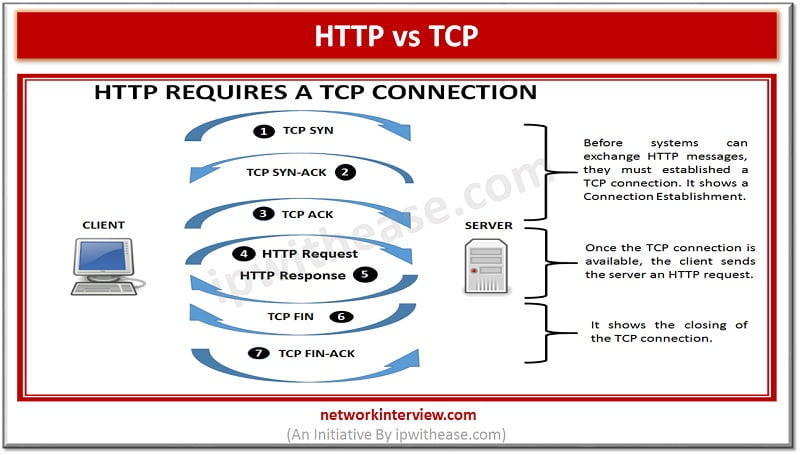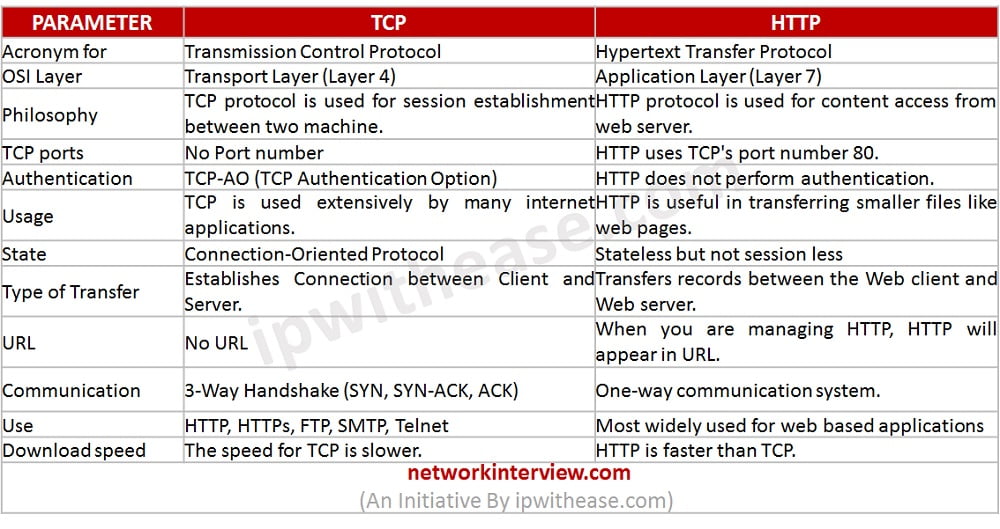
HTTP vs TCP : Detailed Comparison
Before discussing the difference, let’s understand the two terms first
What is HTTP?
HTTP is a Hypertext Transfer Protocol. HTTP works similar to other application services like SMTP and FTP. Like the performance of FTP, it transfers a document using service of TCP port. But it uses just one TCP connection i.e. at data link and no individual Control Connection is used.
HTTP is a protocol which fetches resources such as HTML documents. It is used for exchanging data on the Web and is a client-server protocol which means requests are initiated by the recipient usually the Web browser.
The controls from the client-side delivered in a request message into the webserver. The web server sends the requested content at a response message. The HTTP doesn’t provide any security and makes use of SSL (Secure Socket layer) to club security in its communication.
How does HTTP works
HTTP provides users a way by distributing hypertext messages between servers and clients to interact. HTTP clients generally use Transmission Control Protocol (TCP) connection to communicate with servers.
HTTP uses various tasks to be performed by request methods which are enlisted as below –
- GET = Requests a specific source in its entirety.
- HEAD = A specific resource with no body content.
- POST = Adds articles, messages and information to another page under an existing web resource.
- PUT = Directly modifies a current web source and creates a new URL if need be.
- DELETE = Eliminates a specified source.
- TRACE = Shows users any modifications or additions made to an internet resource.
- OPTIONS = Show user’s which HTTP methods are available for a particular URL.
- CONNECT = Transforms the requested link.
- PATCH = Partially modifies an internet resource HTTP servers use the GET and HEAD methods.
Related – FTP vs HTTP
What is TCP ?
TCP is a connection-oriented protocol which states a connection is established and maintained until the application data at each end have finished exchange. TCP breaks application data into packets. This packet delivers to the transport layer. Layer 4 manages flow control and provide error free data transmission and handles retransmission of dropped or garbled packets and acknowledges all packets that arrive. In the OSI model, TCP covers parts of Layer 4 the transport layer and Layer 5 covers the session layer.
How TCP Works
TCP’s job is to ensure that all data sent in a stream moves from client to server in a correct order and is intact. TCP uses a technique known as positive acknowledgement with retransmission, requiring the receiving end of a transmission to give a response as to what data has been received. The bytes sent can exactly match the bytes received. No data is altered or lost along the way.
Connection is established and a 3-way handshake is made. First, the source sends a SYN request packet to the server in order to start session establishment process. Then, the server sends a SYN-ACK packet to agree to the process. Lastly, the source sends an ACK packet to the target to confirm the process, after which the data can be sent.
Comparison of TCP and HTTP
- HTTP is a Hypertext Transfer Protocol, whereas TCP full form is Transmission Control Protocol.
- HTTP is utilized to access websites, while TCP is a session establishment protocol between client and server.
- HTTP uses port 80 and TCP uses no port.
- HTTP doesn’t need authentication, whereas, TCP uses the TCP-AO.
- HTTP is Stateless but not session less. In contrast, TCP is a Connection-Oriented Protocol.
- HTTP is a One-way communication system, while on the other hand, TCP is a 3-Way Handshake (SYN, SYN-ACK, ACK).
- In case you’re using HTTP, HTTP appears in the URL of the site, and if you’re using TCP, TCP appears in IP.
- HTTP establishes data link communication only but TCP establishes session connection.
- HTTP is useful for transfer of smaller documents like webpages, on the other hand, TCP is useful to setup connection for data transfer.
- HTTP is faster in comparison to TCP, which is slower.
Difference Table : HTTP vs TCP
PARAMETER | TCP | HTTP |
| Acronym for | Transmission Control Protocol | Hypertext Transfer Protocol |
| OSI Layer | Transport Layer (Layer 4) | Application Layer (Layer 7) |
| Philosophy | TCP protocol is used for session establishment between two machine. | HTTP protocol is used for content access from web server. |
| TCP ports | No Port number | HTTP uses TCP’s port number 80. |
| Authentication | TCP-AO (TCP Authentication Option) | HTTP does not perform authentication. |
| Usage | TCP is used extensively by many internet applications. | HTTP is useful in transferring smaller files like web pages. |
| State | Connection-Oriented Protocol | Stateless but not session less |
| Type of Transfer | Establishes Connection between Client and Server. | Transfers records between the Web client and Web server. |
| URL | No URL | When you are managing HTTP, HTTP will appear in URL. |
| Communication | 3-Way Handshake (SYN, SYN-ACK, ACK) | One-way communication system. |
| Use | HTTP, HTTPs, FTP, SMTP, Telnet | Most widely used for web based applications |
| Download speed | The speed for TCP is slower. | HTTP is faster than TCP. |
Conclusion
TCP stands in Transport Layer of OSI Model and is responsible for connection oriented communication between client and server. HTTP is an Application Layer protocol that is a request/response between client and server. TCP provides communication services between a sender and receiver. Client sends a request and the server sends a reply ACK back to the client after 3-way handshake they start data transmission. HTTP transfer web contetnt that user requested.
Download the difference table here.
Continue Reading:
Tag:comparison




